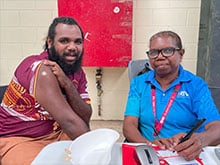As Australia approaches 85% of over-16s double-dosed, Indigenous communities have been disproportionately left out. Some Aboriginal communities have not yet reached full vaccination status for even a third of their residents.
This disparity has become exceedingly clear in recent weeks as the nation watches the Katherine and Robinson River cluster grow in the Northern Territory. Yesterday’s case numbers bring the total up to 25 confirmed cases, with almost all of infected being Indigenous citizens.
In Katherine, the jab rate is 71%, but for some Indigenous communities in central Australia, vaccination is sitting at below 10% double-dosed. Professor James Charles says “The difference in vaccination rates are … a bit of a national and state shame.”
This is particularly concerning considering Australia’s plan to reopen international borders within a month. The low vaccination rates in Indigenous communities are a ticking time bomb. Many Indigenous people are also disproportionately affected by high levels of comorbidities like diabetes.
But Indigenous vaccination hasn’t been a tragedy everywhere. Some Aboriginal communities in Queensland have achieved exceptionally high rates, like Pormpuraaw with 82.9% double-dosed, and Wujal Wujal with 72.2%.

The Guardian reports that “overall, there is a 19 percentage point difference between the Indigenous and overall first-dose vaccination rates in most of the priority areas.” In order to combat virus spread in these vulnerable communities, better information needs to be prioritised to combat the plague of misinformation.
‘Door-to-door’ vaccination has been particularly successful in such situations, facilitating better communication in local Indigenous languages with the vaccine-hesitant. Targeted action is needed before borders reopen. As Dr Charles warns, “If we’re opening state borders up and we’ve got communities left vulnerable, it could really be a catastrophe.”
Follow Maddie’s journalism journey on Twitter.